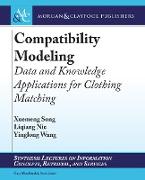- Start
- Compatibility Modeling: Data and Knowledge Applications for Clothing Matching
Compatibility Modeling: Data and Knowledge Applications for Clothing Matching
Angebote / Angebote:
Nowadays, fashion has become an essential aspect of people's daily life.As each outfit usually comprises several complementary items, such as a top, bottom, shoes, and accessories, a proper outfit largely relies on the harmonious matching of these items. Nevertheless, not everyone is good at outfit composition, especially those who have a poor fashion aesthetic. Fortunately, in recent years the number of online fashion-oriented communities, like IQON and Chictopia, as well as e-commerce sites, like Amazon and eBay, has grown. The tremendous amount of real-world data regarding people's various fashion behaviors has opened a door to automatic clothing matching.Despite its significant value, compatibility modeling for clothing matching that assesses the compatibility score for a given set of (equal or more than two) fashion items, e.g., a blouse and a skirt, yields tough challenges: (a) the absence of comprehensive benchmark, (b) comprehensive compatibility modeling with the multi-modal feature variables is largely untapped, (c) how to utilize the domain knowledge to guide the machine learning, (d) how to enhance the interpretability of the compatibility modeling, and (e) how to model the user factor in the personalized compatibility modeling. These challenges have been largely unexplored to date.In this book, we shed light on several state-of-the-art theories on compatibility modeling. In particular, to facilitate the research, we first build three large-scale benchmark datasets from different online fashion websites, including IQON and Amazon. We then introduce a general data-driven compatibility modeling scheme based on advanced neural networks. To make use of the abundant fashion domain knowledge, i.e., clothing matching rules, we next present a novel knowledge guided compatibility modeling framework. Thereafter, to enhance the model interpretability, we put forward a prototype wise interpretable compatibility modeling approach. Following that, noticing the subjective aesthetics of users, we extend the general compatibility modeling to the personalized version. Moreover, we further study the real-world problem of personalized capsule wardrobe creation, aiming to generate a minimum collection of garments that is both compatible and suitable for the user. Finally, we conclude the book and present future research directions, such as the generative compatibility modeling, virtual try-on with arbitrary poses, and clothing generation.
Folgt in ca. 15 Arbeitstagen

